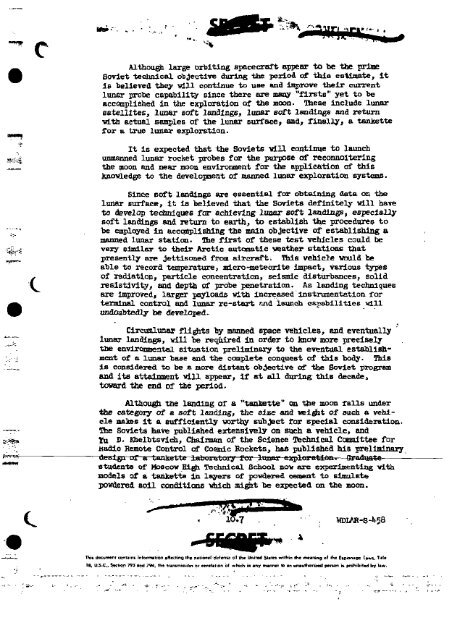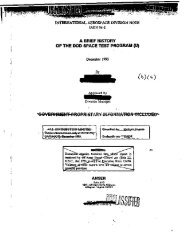LUNAR EXPEDITION PLAN
LUNAR EXPEDITION PLAN
LUNAR EXPEDITION PLAN
You also want an ePaper? Increase the reach of your titles
YUMPU automatically turns print PDFs into web optimized ePapers that Google loves.
^*^<br />
Although large orbiting spacecraft appear to be the prime<br />
Soviet technical objective during the period of this estimate, it<br />
is believed they will continue to uBe and Improve their current<br />
lunar probe capability since there are many "firsts" yet to be<br />
accomplished in the exploration of the moon. These include lunar<br />
satellites, lunar soft landings, lunar soft landings and return<br />
•with actual samples of the lunar surface, and, finally, a tankette<br />
for a true lunar exploration.<br />
It is expected that the Soviets will continue to launch<br />
iss:-;:s- unmanned lunar rocket probes for the purpose of reconnoitering<br />
^ the moon and near moon environment for the application of this<br />
knowledge to the development of manned lunar exploration systems.<br />
Since soft landings are essential for obtaining data on the<br />
lunar surface, it is believed that the Soviets definitely will have<br />
to develop techniques for achieving lunar soft landings, especially<br />
soft landings and return to earth, to establish the procedures to<br />
"'/,'_*' be employed in accomplishing the main objective of establishing a<br />
manned lunar station. The first of these test vehicles could be<br />
very similar to their Arctic automatic weather stations that<br />
•IS;-*<br />
presently are Jettisoned from aircraft. This vehicle would be<br />
able to record temperature, micro-meteorite impact, various types<br />
of radiation, particle concentration, seismic disturbances, solid<br />
c<br />
resistivity, and depth of probe penetration. As landing techniques<br />
are improved, larger payloads with increased instrumentation for<br />
terminal control and lunar re-start ft-".d launch capabilities will<br />
undoubtedly be developed.<br />
Circumlunar flights by manned space vehicles, and eventually<br />
"7" lunar landings, will be required in order to know more precisely<br />
the environmental situation preliminary to the eventual establish-<br />
•< ment of a lunar base and the complete conquest of this body. This<br />
j_.-_ is considered to be a more distant objective of the Soviet program<br />
and its attainment win appear, if at all during this decade,<br />
toward the end of the period.<br />
Although the landing of a "tankette" on the moon falls under<br />
the category of a soft landing, the size and weight of such a vehicle<br />
mates it a sufficiently worthy subject for special consideration.<br />
—- The Soviets have published extensively on such a vehicle, and<br />
=*a Yu D. Kbelbtsvieh, Chairman of the Science Technical Committee for<br />
Hadio Remote Control of Cosmic Rockets, has published his preliminary<br />
c<br />
design of a lankette laboratory for lunar exploration. Graduate<br />
students of Moscow High Technical School now are experimenting with<br />
models of a tankette in layers of powdered cement to simulate<br />
powdered soil conditions which might be expected on the moon.<br />
WDLAR-S-^58<br />
thii dDcim>ent conta in* information jflecling Ihe najtonal tfefemj of (ha United 5l*t« within tht meaning of *he Eicnonagc Law*. Till*<br />
IS, LL5X*, Section 793 and 794, the trantmiHtan of revelation of which in any manner to en unautharfcied partem h prohibited by lew,




